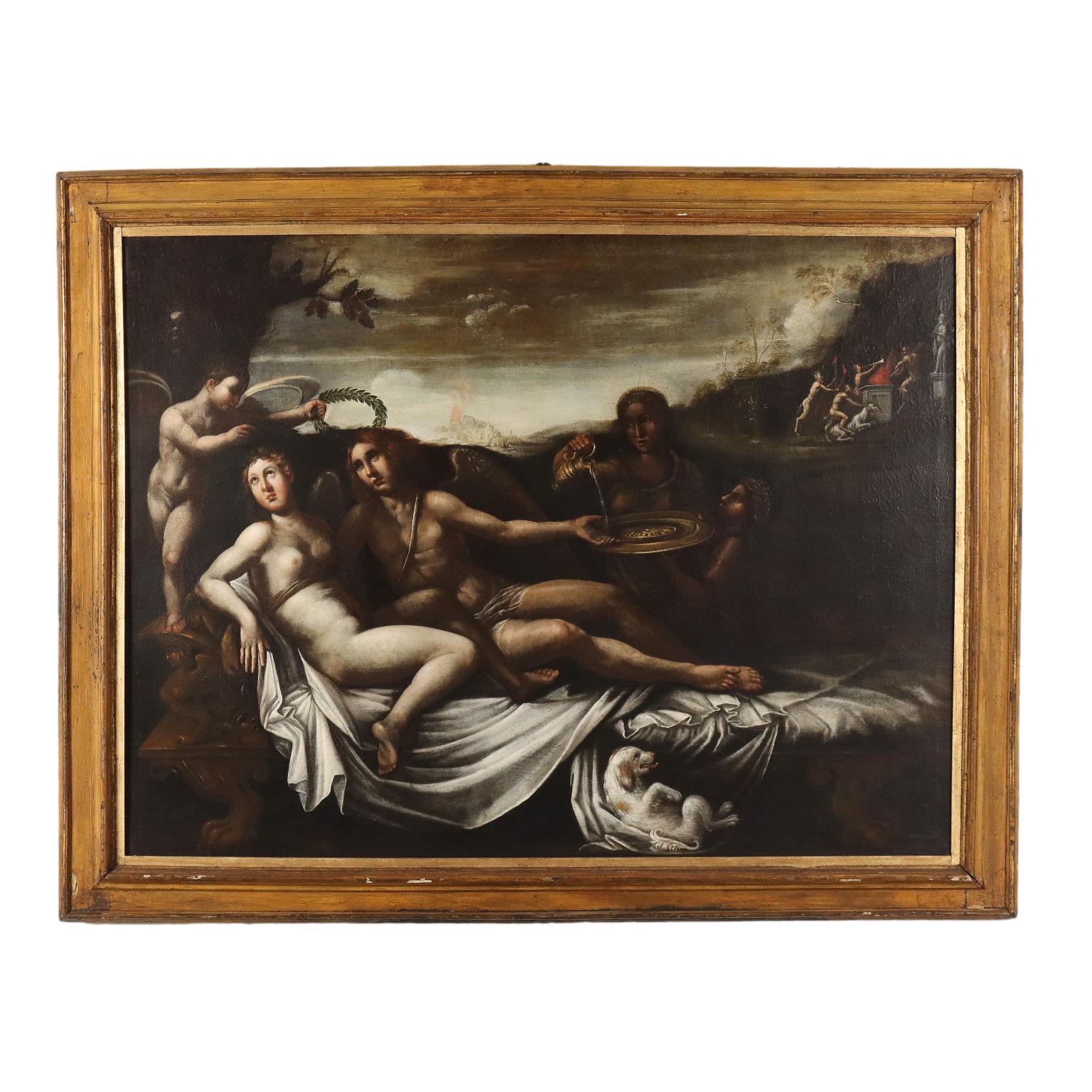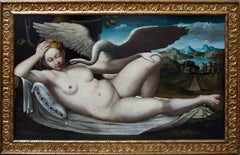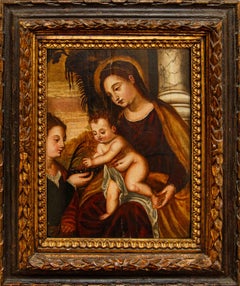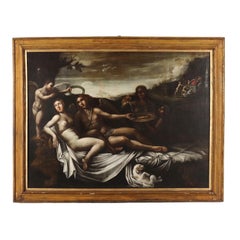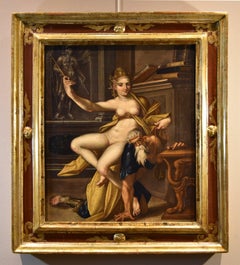Items Similar to Lambert Sustris's workshop (1515-1520 - c. 1584), Venus and Love Spied on
Want more images or videos?
Request additional images or videos from the seller
1 of 12
Lambert Sustris's workshop (1515-1520 - c. 1584), Venus and Love Spied on16th Century
16th Century
$4,910.73
£3,639.12
€4,100
CA$6,704.08
A$7,458.02
CHF 3,909.59
MX$91,135.17
NOK 49,783.71
SEK 46,864.48
DKK 31,217.04
Shipping
Retrieving quote...The 1stDibs Promise:
Authenticity Guarantee,
Money-Back Guarantee,
24-Hour Cancellation
About the Item
Lambert Sustris workshop (1515-1520 -approximately 1584)
Venus and Love spied on by a satyr
Oil on panel, 24 x 32 cm
Framed, 41 x 49 cm
The tablet described here, which can be attributed to the workshop of Lambert Sustris, depicts a subject of a mythological character that was very dear to private patrons in the 16th century, as the works made by contemporary artists for the collections and residences of noble and wealthy families both from Italy and abroad can well testify. The protagonist figure is that of Venus, accompanied by her little son Cupid, both referable to the erotic and sensual universe, almost completely naked on a bed where they had dozed off; disturbing their sleep is a satyr, perhaps the god Pan himself, who discreetly appears beyond the red curtain and begins to pull at the white sheet covering the goddess' intimacies. The atmosphere could be interpreted as a mythological portrayal of the pleasures of carnal love, although parts of the work leave room for further reflection: the satyr's earthly and irrational desire seems to be screened by Cupid's action, thrown at the Silenus to prevent him from pulling the curtain and sheet further; moreover, the god's love arrows are far away, resting beside the bed, and the same goddess averts her gaze from the unwelcome visitor. This juxtaposition of desire and demureness is one of the recurring themes recurring among the "chamber" paintings, intended for the strictly private rooms of stately homes and often featuring themes of erotic content, for the delight of the master of the house. The painting highlights several Mannerist characteristics: the elongated figures and complex poses, attention to the human form, which is often idealized and sensual, bright and contrasting colors (the red of the canopy, the white of the sheet, and the dark tones of the Satyr create a strong visual impact), dynamism and theatricality (the interaction between the figures and the surprise of the Satyr give the scene a sense of movement and drama).
Lambert Sustris (Amsterdam, c. 1515-1520 - Padua?, c. 1584) was a Dutch painter, father of Friedrich Sustris. He trained in Utrecht or Haarlem in the environment of Jan van Scorel or Maarten van Heemskerck. At a young age he visited Rome, as is confirmed by the discovery of his signature in the Domus Aurea, and Venice, where he entered Titian's atelier. As a member of the famous painter's entourage, he attended the Diet of Augsburg in 1548 and 1550, where he returned in 1542 and had the opportunity to portray numerous Swabian nobles, such as those of the Vöhlin family. Starting in 1543 he painted the fresco cycle of the Villa dei Vescovi in Luvigliano di Torreglia. Between 1548 and 1553 he visited Augsburg several times; the numerous portraits he painted for nobles and clergy date from this period. In his sixties he settled in Padua, where he likely died in an unspecified year after 1568.
Its particular fusion of Dutch and Italian styles was a decisive model for the development of ideal landscapes in the 17th century.
- Creation Year:16th Century
- Dimensions:Height: 9.45 in (24 cm)Width: 12.6 in (32 cm)
- More Editions & Sizes:cm 24 x 32Price: $4,911
- Medium:
- Circle Of:Lambert Sustris (1515 - 1584)
- Period:
- Condition:
- Gallery Location:Milan, IT
- Reference Number:1stDibs: LU2639216689812
About the Seller
No Reviews Yet
Vetted Professional Seller
Every seller passes strict standards for authenticity and reliability
1stDibs seller since 2023
Typical response time: <1 hour
- ShippingRetrieving quote...Shipping from: Milan, Italy
- Return Policy
Authenticity Guarantee
In the unlikely event there’s an issue with an item’s authenticity, contact us within 1 year for a full refund. DetailsMoney-Back Guarantee
If your item is not as described, is damaged in transit, or does not arrive, contact us within 7 days for a full refund. Details24-Hour Cancellation
You have a 24-hour grace period in which to reconsider your purchase, with no questions asked.Vetted Professional Sellers
Our world-class sellers must adhere to strict standards for service and quality, maintaining the integrity of our listings.Price-Match Guarantee
If you find that a seller listed the same item for a lower price elsewhere, we’ll match it.Trusted Global Delivery
Our best-in-class carrier network provides specialized shipping options worldwide, including custom delivery.More From This Seller
View AllFrom Paolo Veronese, Allegory of Strength and Wisdom
By Paolo Veronese
Located in Milan, IT
Follower of Paolo Veronese (Verona, 1528 - Venice, 1588)
Allegory of wisdom and strength
Oil on canvas, 48 x 36.5 cm
Picture frame, 61 x 48 cm
The Allegory of Wisdom and Strength...
Category
16th Century Other Art Style Figurative Paintings
Materials
Canvas, Oil
School of Andrea del Sarto (Florence, 1486 - Florence, 1530), San Giovannino
By Andrea Del Sarto
Located in Milan, IT
School of Andrea del Sarto (Florence, 1486 - Florence, 1530)
Saint John
Oil on panel, 57 x 39 cm
Framed, 67 x 49 cm
The panel depicts St. John, recognizable by his staff and red ...
Category
16th Century Other Art Style Figurative Paintings
Materials
Canvas, Oil
Herman Posthumus (East Frisia, 1512/1513 - Amsterdam, 1588), Leda
Located in Milan, IT
Herman Posthumus (East Frisia, 1512/1513 - Amsterdam, 1588)
Leda & the Swan
Oil on canvas, 87.5 x 142 cm
Framed, 107 x 161 cm
Initial 'P' in the center of a pillow decoration
Cr...
Category
16th Century Other Art Style Nude Paintings
Materials
Oil, Canvas
Polidoro de' Renzi, called Polidoro da Lanciano, Mystic Marriage
Located in Milan, IT
Polidoro de' Renzi, called Polidoro da Lanciano (Lanciano, c. 1515 - Venice, 1565)
Mystic Marriage of St. Catherine
Oil on panel, 47.5 x 34.5 cm
Framed, 71 x 58 cm
The painting, ...
Category
16th Century Other Art Style Figurative Paintings
Materials
Canvas, Oil
Girolamo Maria Pesci (Rome, 1679 - 1759), The judgment of Paris
Located in Milan, IT
Girolamo Maria Pesci (Rome, 1679 - 1759)
The judgment of Paris
c. 1705-1710
Oil on canvas, 47 x 36.5 cm
Girolamo Maria Pesci (Rome, 1679 - 1759), a figure distinguished for his e...
Category
18th Century and Earlier Other Art Style Figurative Paintings
Materials
Canvas, Oil
Mid-17th century, Rubensian School, Holy Family with St. John
By (After) Peter Paul Rubens
Located in Milan, IT
Mid-17th century, Rubensian School
Holy Family with St. John and Elizabeth
Oil on copper, 36.3 x 29.5 cm
Framed, 47 x 38 cm
The painting is not signed
The glassy texture, glacia...
Category
18th Century and Earlier Other Art Style Figurative Paintings
Materials
Canvas, Oil
You May Also Like
Painting with Mythological Scene Love and Psyche 18th century
Located in Milan, IT
Oil on Canvas. School north -Italy 17th century.
The scene is based, with some variations but very close in size, on a part of the large fresco entitled "Banquet of the Gods" in th...
Category
18th Century and Earlier Other Art Style Figurative Paintings
Materials
Oil
Painting with The Rape of the Sabine Women, 17th century
Located in Milan, IT
Oil on Canvas. Roman school of the 17th century.
The large scene depicts the famous episode somewhere between real history and legend, first recounted by Titus Livius in his "Ab urb...
Category
17th Century Other Art Style Figurative Paintings
Materials
Oil
Venus Paolo Fiammingo Paint Oil on canvas Old master 16th Century Italian Art
Located in Riva del Garda, IT
Pauwels Franck, known as Paolo Fiammingo
(Antwerp, 1540 - Venice, 1596)
Venus lying in a landscape
Oil on canvas 116 x 150 cm.
In antique frame 136 x 170 cm.
The work is accompanied by a critical card by Dr. Federica Spadotto
The splendid painting proposed sees portrayed, bare and stretched out on a red brocade cloth in gold sprinkled with roses, a refined and sensual Venus, in a composition with a profound symbolic value, and arriving at the perfect representation of the Renaissance woman who, like Venus, becomes an allegory love, eros, beauty and fertility.
The canvas is part of the prestigious Venetian artistic and cultural environment of the second half of the sixteenth century, whose distinctive distinctive trait can be traced back to its cosmopolitan vocation. This characteristic, as Dr. Spadotto noted in her in-depth study, belongs to the same physiology of the Venetian capital, that is, being a distinctly commercial city located in a strategic point with respect to trade. Representing one of the liveliest ports in the Mediterranean also meant witnessing the continuous passage not only of goods, but of men, ideas, suggestions from distant countries, which influenced not only the taste of their people, but above all art.
This happened thanks to the circulation of prints, as well as pictorial specimens, to which are added the stays of great foreign artists and, above all, the permanence in the capital of a non-negligible number of Dutch, Flemish and German masters.
An emblematic case in this regard comes from Pauwels Franck (Antwerp, 1540 - Venice, 1596), better known as Paolo Fiammingo, who established himself in his native city at a young age - in 1561 a figure enrolled in the Guild of San Luca - and arrived in Venice in 1573. .
He resided in Venice from 1584 until his death, although the stylistic and formal references of some of his works have led critics to believe that in previous years he had undertaken a journey to central Italy, or to Florence and Rome, where he would have metabolized the lively cultural debate that permeated these cities and which, on the other hand, seemed completely absent in Venice.
Here Paolo will be fascinated by the sense of color and by the atmospheric component fixed on the canvas by Jacopo Tintoretto (Venice 1518 - 1594), of which he becomes a collaborator, to undergo, around 1590, the suggestion of Paolo Caliari...
Category
16th Century Old Masters Paintings
Materials
Oil
$34,878 Sale Price
20% Off
Aristotle Phyllis Spranger 16/17th Century Paint Oil on canvas Old master
Located in Riva del Garda, IT
Bartholomäus Spranger (Antwerp, 1546 – Prague, 1611) workshop
Aristotle and Phyllis
Oil on canvas 64 x 54 cm In frame 79 x 72 cm
The curious subject of this painting, quite...
Category
16th Century Old Masters Paintings
Materials
Oil
Painting The Preaching of St. John the Baptist, 17th-18th century
Located in Milan, IT
Oil on Canvas. North Italian school of the 17th-18th centuries.
The large scene is filled with figures in ancient Eastern garb, set in a northern, richly vegetated landscape with mou...
Category
Late 17th Century Other Art Style Figurative Paintings
Materials
Oil
Banquet with Figures Memento Mori Italian 17th Century After Giovanni Martinelli
Located in Milano, IT
Antique Painting of 1600s Banquet with Figures Memento Mori after Giovanni Martinelli death comes to the banquet table-memento mori circa 1635. The oil on canvas painting (lined with...
Category
Mid-17th Century Baroque Figurative Paintings
Materials
Canvas, Oak, Oil
